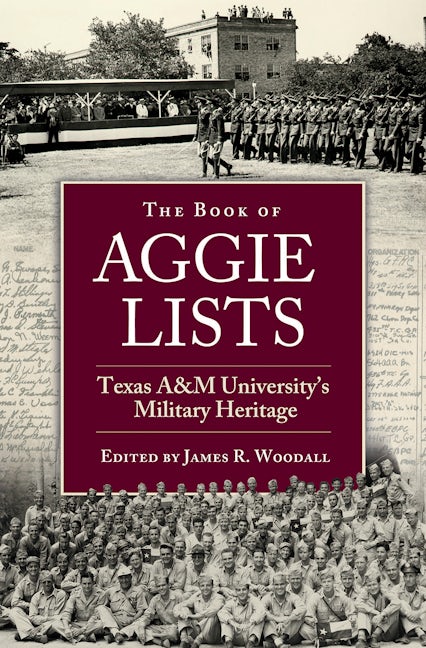How do you buy a star?
20 A&M Men in the Normandy American Cemetery
10,556 Views |
59 Replies |
Last: 3 mo ago by Got a Natty!
I'm updating each profile so pictures will be visible
Where do you get your information about whether there are Aggies buried at these cemeteries? I was just at the US WWII cemetery in Luxembourg a few weeks ago.
This book contains the information for each American cemeteryAgs83 said:
Where do you get your information about whether there are Aggies buried at these cemeteries? I was just at the US WWII cemetery in Luxembourg a few weeks ago.

https://www.tamupress.com/book/9781623498412/the-book-of-aggie-lists/
thx
All profiles updated with yearbook and memorial images
I am researching all the Aggies killed in WWII, and am now searching the AMBC website
Last night I found the 22nd Aggie buried in the Normandy American Cemetery:
Lt John D McBride Jr, class of 1943
350th Bomber Squadron, 100th Bomber Group (Heavy)
B-17 42-30788 / Mismalovin'
KIA: February 25 1944
Plot A Row 11 Grave 8



Last night I found the 22nd Aggie buried in the Normandy American Cemetery:
Lt John D McBride Jr, class of 1943
350th Bomber Squadron, 100th Bomber Group (Heavy)
B-17 42-30788 / Mismalovin'
KIA: February 25 1944
Plot A Row 11 Grave 8



//Here//
//Herknav sends//
I was at the American cemetery in Normandy a few weeks ago. Now, you really can't get close to the head stones without prior approval and an escort. Too many people visiting now and the foot traffic was killing the grass.
Starting next year, you will need to get timed entry tickets in advance to visit.
Starting next year, you will need to get timed entry tickets in advance to visit.
They had the area roped off last year after June 6th, but I was able to get permission to walk up to the headstones and take pictures.EMY92 said:
I was at the American cemetery in Normandy a few weeks ago. Now, you really can't get close to the head stones without prior approval and an escort. Too many people visiting now and the foot traffic was killing the grass.
Starting next year, you will need to get timed entry tickets in advance to visit.
Visiting in 26; recalling looking forward to the trip.
Peace for Ukraine!
EMY92 said:
I was at the American cemetery in Normandy a few weeks ago. Now, you really can't get close to the head stones without prior approval and an escort. Too many people visiting now and the foot traffic was killing the grass.
Starting next year, you will need to get timed entry tickets in advance to visit.
We were there last week. The two large areas between the memorial and the chapel were roped off, but the two smaller areas behind the chapel were open for people to walk on. I thought this was a little odd - why allow people to walk up to some graves and not others?
We were there with two local guides, and I asked them about this. They said they've been roping off areas for a while, and there is no rhyme or reason as to when they take the ropes down and let people get close to the graves. The guides actually think it's disrespectful to prevent visitors from getting up close, because you can't see any information about who is buried there unless you get close to the marker.
Interesting about the timed entry. I did not feel like the cemetery was so crowded that timed entry would be necessary or make the experience better. Maybe crowds are an issue a few days of the year (like the anniversary of D-Day), but the cemetery is certainly big enough for people to spread out and pay their respects in solitary peace.
We spent almost 5 days in the area and still did not get to see everything I wanted to. But we did manage to visit 2 museums, Omaha Beach, Arromanches, Pointe du Hoc, and the Longues-sur-Mer battery. We also visited a German mausoleum on the way to Mont St Michel.
We rented bikes and rode all the way from Grandcamp Maisy to the cemetery and back through Colleville sur Mer. It was an amazing way to see the area.
This was a "bucket list" trip for me. I have always wanted to visit there and pay my respects.
https://instagr.am/p/DLeTYWyttE7
I hope my post helped you find these markers and know more about them.
It was a great path with excellent views of the channel
I found this trail just off of OMAHA Beach and walked towards Pointe du Hoc and saw the monument to Saint-Pierre-du-Mont Airfields in NormandyQuote:
We rented bikes and rode all the way from Grandcamp Maisy to the cemetery and back through Colleville sur Mer. It was an amazing way to see the area.
It was a great path with excellent views of the channel
The banners you had made and left at the grave markers are so amazing. I was very moved by all of the various mementos - flowers, wreaths, medals, rocks, etc - that were left at the various memorials we visited. It's amazing that, despite the passage of time, people still feel compelled to leave something in honor of the fallen.
ABATTBQ87 said:
Arthur Rider, A&M College of Texas class of 1942 KIA June 21, 1944, while fighting in Normandy, France.
Pictured in the 1942 Longhorn.
Arthur was a member of D Troop Calvary
and the Polo Team.
Lt Rider was in the 4th Cavalry Reconnaissance Squadron and was awarded the Silver Star as he served gallantly in combat against the enemy.
4th Cavalry Reconnaissance Squadron found itself attached to the 82d Airborne Division from 6 June-3 July 1944.
The 82d Airborne Division assigned the cavalry troop combat patrols in the hedgerow country and enjoyed the additional firepower the troop brought with it in the form of 37 mm cannons and machine guns. It was on one of these platoon-sized patrols that the troop lost an entire platoon of men and vehicles, less one jeep and two scouts who managed to escape.
Lacking the support of the troop's other platoons, and beyond the support of the other assets found in every mechanized reconnaissance squadron, the lightly armed platoon faired poorly. Early fighting in Normandy provided one fascinating example of the value of stealth, one of the salient features of the interwar debate on the desired characteristics of a mechanized reconnaissance unit.
In helping to take Auderville, in support of the 9th Infantry Division, Troop B, 4th Cavalry Reconnaissance Squadron, proved the value of wheeled vehicles for mechanized reconnaissance under combat conditions.
Confronted by a continuous line of German defenders, the cavalrymen found a hill behind friendly lines that allowed them to gain enough speed on the descent into enemy lines to gain the speed and momentum to coast undetected into and beyond the German positions. Completely surprised, the Germans retreated under pressure from attacking American infantrymen as the cavalrymen dashed on to Auderville, surprised the garrison, and took control of the village by daylight. This was not characteristic of most of the fighting in Normandy. The 4th Cavalry Squadron participated in the drive to secure the Cherbourg Peninsula. During the advance up the peninsula, the 4th Cavalry Reconnaissance Squadron helped maintain contact between the 9th and 79th Infantry Divisions.
Lt Arthur Rider is buried in the Normandy American Cemetery.
Is there any way ABATTs research can be put on a special page and preserverd for generations
of Aggies and intereststed partirs ? Both Military ans History posts!
Thanks BigJim; I'm working on developing a website for all of this information
As you all know, I am researching all the Aggies killed in WWII, and today I found the 23rd Aggie buried in the Normandy American Cemetery:
Staff Sergeant Robert Loin Terry was a World War II casualty who is buried at the Normandy American Cemetery in France. He was born on April 17, 1919, in Hutchinson County, Texas, and attended Texas A&M. He entered the service from Arkansas and served in the U.S. Army.
Sgt. Terry was a member of the 90th Infantry Division, 359th Infantry Regiment. He was killed in action on July 11, 1944, during the fighting near Saint-L, Normandy, France. He was posthumously awarded the Purple Heart. His final resting place is at Plot F, Row 27, Grave 17, at the Normandy American Cemetery in Colleville-sur-Mer, France.
Here is a picture of him in his A&M Class A winters, AMC brass is visible:

I believe he was in Company L Infantry, per the picture and roster in the 1942 Longhorn:

Staff Sergeant Robert Loin Terry was a World War II casualty who is buried at the Normandy American Cemetery in France. He was born on April 17, 1919, in Hutchinson County, Texas, and attended Texas A&M. He entered the service from Arkansas and served in the U.S. Army.
Sgt. Terry was a member of the 90th Infantry Division, 359th Infantry Regiment. He was killed in action on July 11, 1944, during the fighting near Saint-L, Normandy, France. He was posthumously awarded the Purple Heart. His final resting place is at Plot F, Row 27, Grave 17, at the Normandy American Cemetery in Colleville-sur-Mer, France.
Here is a picture of him in his A&M Class A winters, AMC brass is visible:

I believe he was in Company L Infantry, per the picture and roster in the 1942 Longhorn:
Flight Officer John A. De Bell, A&M Class of 1946, from Harris County, served in the 394th Bombardment Group (Medium) and the 587th Bombardment Squadron during World War II as a navigator/bombardier on a B-26 Marauder.
On April 21, 1944, De Bell's plane was shot down over France. The plane's pilot was Theodore E. Kubala, and the co-pilot was William G. Jones. De Bell, along with Kubala and Jones, went down with the aircraft.
Flight Officer John A. De Bell is buried in the Normandy American Cemetery and Memorial Plot A, Row 16, Grave 31.
On April 21, 1944, De Bell's plane was shot down over France. The plane's pilot was Theodore E. Kubala, and the co-pilot was William G. Jones. De Bell, along with Kubala and Jones, went down with the aircraft.
Flight Officer John A. De Bell is buried in the Normandy American Cemetery and Memorial Plot A, Row 16, Grave 31.
Is there a section of the American Cemetery in Luxembourg where the Aggies are buried?
Waiting on a Natty said:
Is there a section of the American Cemetery in Luxembourg where the Aggies are buried?
There are no A&M sections, just random plots.
I have a list of the Aggies in Luxembourg so if you need it just let me know
Could you email that to me?
I'm going next May.
markcotter80atyahoodotcom
I'm going next May.
markcotter80atyahoodotcom
Email sent
Reply email sent.
Thank you.
Thank you.
Featured Stories
See All
5:01
15h ago
2.1k
Reed Report: Fair expectations for McMillan's Ags as SEC action arrives
by Luke Evangelist
Three Things: Transfer portal season officially begins on Friday
by Jason Howell
Mike Elko elevates Joey Lynch to Texas A&M's quarterback coach
by Richard Zane

